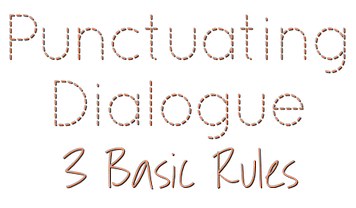
When writing fiction, dialogue is a big part of making your story come to life for your readers. Punctuating it properly is important. Here are three basic rules to get you started with using quotation marks to indicate dialogue in your writing.
1. Only spoken words go within quotation marks.
"The tournament is on Saturday," Angie said.
or
"She loved you," he said, "but you had no idea, did you?"
2. A different character speaking or responding with an action gets a new line or paragraph.
"Hello," he said.
Angie looked up from her book. "Hi, how are you?"
"I'm not doing so bad. What are you reading?"
Angie smiled. She was sure he wasn't interested in what she was reading. The book in her hands wasn't exactly everyone's type of book.
He laughed. "You don't have to tell me."
3. Punctuation marks belong inside quotation marks. Take note of the capitalization in a dialogue tag after a character asks a question.
Angie yelled, "I told you never to show your face here ever again. Now you're gonna pay!"
or
"What time does your class start?" he asked.
or
"I'm not sure she knows what you're talking about," he said with a chuckle. "Don't you think she would've told Angie if she did?"

We're not just talking about a planner for writers.
It's the planner you've been searching for.
Story organization with no wasted planner space. Utilize every page, no matter what is going on in your world.

There are many things that can alter punctuation when it comes to dialogue. Here are a few different ways you can express what is happening around or during dialogue.
- Use an ellipsis if the speaker trails off with their words.
Angie sighed loudly. "I just don't understand why she . . . "
"I know . . . it's okay."
-
Use an em dash if the speaker gets interrupted by another character in some
way.
To get an em dash, hold the Ctrl and Alt buttons then press the minus sign on your number pad (not the numbers above the letters, the ones on the number pad). You can also get an em dash by holding Alt, pressing 0151 (individually and in that order) on your number pad, and letting go of the Alt key.
Shaking her head no, Angie said, "But Mom said to—"
"I don't care what Mom told you," said her brother.
- Also use em dashes if the speaker doesn't interrupt their speech but performs an action while they are speaking.
"Just look"—Angie pointed at the floor—"at all the toys. I told you to put them away!"
